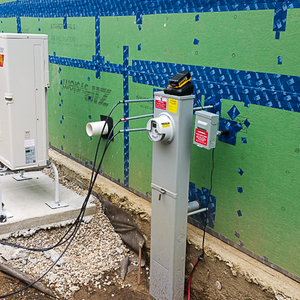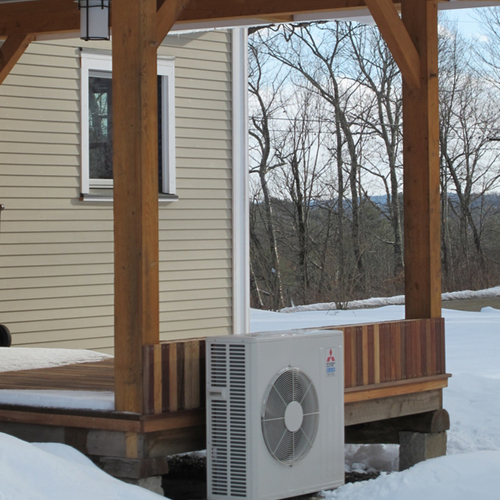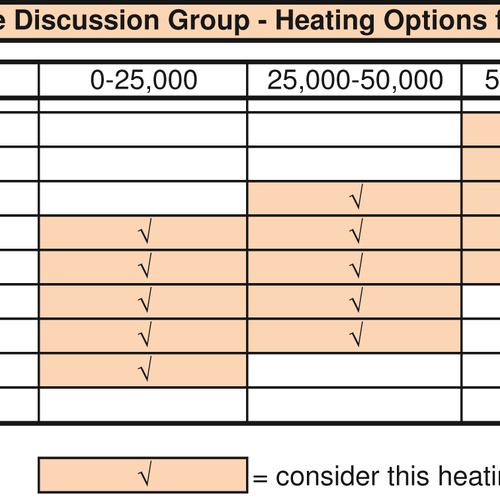
Carl is going the minisplit route in his new home but also will be installing supplemental heating equipment—the question is what kind.
“We are being required to install additional heat sources in each and every bedroom and bathroom for backup,” Carl writes in this recent Q&A post.
There may not be much call for supplemental heat. The house will have double-stud walls, raised heel trusses for added insulation in the roof, and will be carefully air sealed. But have it he must. Carl’s HVAC contractor is planning to install a Cadet in-wall electric resistance heater in each room, with an electric radiant floor in the bathroom.
“The bathrooms will be used for 20-25 minutes each morning and night,” Carl says. “I don’t want to run these things for hours. The bedroom heaters may not ever be used. We set our nighttime temps very low and prefer blankets over whole-house heating for sleeping hours; it’s much more pleasant.”
Would radiant panels in the ceiling work? What about in-floor electric resistance heat? Are there other options to consider? Those are questions for this Q&A Spotlight.
Who is requiring supplemental heat?
Peter Engle, among others, wants to know who exactly is requiring Carl to install backup heat.
“If it is a local jurisdiction and you are confident that you won’t need it, I would go with the cheapest solution and even consider removing it once the house is finished,” Engle says.
Carl himself isn’t entirely sure why supplemental heat would be required.
“Good question,” he replies, “and one I have asked by GC more than once. I may have to chase it down myself. Suffice to say, the minute you say you intend to use a minisplit system and refuse to install forced…
Weekly Newsletter
Get building science and energy efficiency advice, plus special offers, in your inbox.

This article is only available to GBA Prime Members
Sign up for a free trial and get instant access to this article as well as GBA’s complete library of premium articles and construction details.
Start Free TrialAlready a member? Log in















25 Comments
Scott,
You wrote, "Malcolm Taylor says Carl might consider a plug-in electric heater made by Convectair. The heaters, which run on a 12-volt circuit, are available in 500- and 1250-watt versions."
I would be astonished if these high wattage heaters really operate on a 12-volt circuit. A 1250 watt heater draws 104 amps at 12 volts. That's a huge amount of current -- it would require a very fat wire.
I'm sure he meant 120 volt. 😊
When we were trying to insure our Pretty Good House in 2015, we had to change insurers because the company that insured our old house refused to insure a house heated only by heat pumps, which they believed didn't work in cold climates.
I am having a hard enough time with distribution without having to worry about supplemental distribution! Thankfully nobody has even mentioned the possibility of needing backup heat sources, but I have never asked an insurance company. We will have a single gas direct vent fireplace in the great room for supplemental heat, but for the rest of the house I'm counting on the extra insulation getting us through when it's too cold for the mini-splits. Also our crawlspace is built like a short basement and heated by electric resistance heaters, so in a way that's backup heat for the house by continuing to feed heat upward.
Distribution was not easy though with a lot of individual rooms, many with tiny loads (500-1000 watts each) and this article parallels a lot of the thoughts we went through. We also changed our tune about the desirability of increased number of splits after this summer, which is the first time ever I'd wish for AC in my CZ6. The world is changing, that's for sure. For example we were going to do a cove heater or a wall electric fireplace heater in the master bedroom, and just made the decision to instead add a 6th split head. Our baths have electric Ditra-heat. And our only other area of concern is the mudroom which will probably have a toekick heater since we've covered all the walls with cabinets.
Any brands you would suggest for relatively quiet toekick heaters?
We're using the Stiebel Eltron wall mount convection wall heaters with built-in thermostats for supplemental heating in bathrooms and north facing bedrooms with a 9000 BTU Fujitsu single head mini split in our 1024sf zero energy build. https://www.stiebel-eltron-usa.com/products/cns-e-wall-mounted-convection-heaters. We have used Cadet wall heaters in the past, and they work well, but are pretty loud. The Stiebel Eltron heaters are quiet and do not take up floor space like baseboard versions. Although the small footprint home has fresh air/exhaust ducts throughout (improving heating and cooling distribution via Build Equinox's CERV), our client is an aging adult who may also be caring for her 95 year old mom in the future. Some folks like extra warm bathrooms and bedrooms, some folks don't. Client comfort is priority one.
I guess I shouldn't be surprised that insurance companies and building departments are creating these problems but nevertheless I am. Showing them a manual J calculation should be sufficient if you can get them to understand what it is.
I am definitely not an expert but can comment from our experience of a well insulated and air sealed new home in the relatively mild climate of the outer SF Bay area.
It is all electric, 2,300 sf with a great room in the center and master bed/ bath on one side and 2 beds and bath on the other. We have two ducted mini splits one for each end of the house which give short duct lengths.
I n addition we have heated floors in the bathrooms which are great even in summer to take of the chill ( this time of year we sleep with windows open to cool down the house and give us a cooler bedroom). The floors are on a timer for a few hours in the am and an hour or so in the evening.
We also have heated towel rails which actually seem to add heat to the room although their primary purpose of course is to heat the towels. Again they are on a timer and add a little bit of luxury to our morning. They are really quite cheap, I think our basic models were about $150. They are pretty much standard equipment in the UK with a cooler damper climate.
Finally we have an electric 'steam' fire, Opti-myst Pro 1000 by Dimplex for ambiance. It is plumbed in to a water supply which is heated to create the steam. LED lights are used to give the fire effect which is remarkably good, certainly as good as you can get with out combustion. It also has an electric resistance heater which we have never used. The cost was about $3,000 2 years ago which given the ease of installation - plug into a 120v outlet and the water supply - I thought was very good. You can get fake logs and other gizmos if you like but we are happy with the basics. I will add that this is a great product but the marketing was very confusing as to what we were actually getting, hopefully this has improved.
I hope some of these experiences may be useful.
Would Runtal electric radiant panels be a viable option here?
https://runtalnorthamerica.com/residential-electric-wall-panels/
Has a heat load calc been done on this house? I'd push back on anyone saying this house cannot be "adequately heated." If the mini-splits can do the job, it can be demonstrated they can do the job, and there are well-established methods for doing so. Every code I've seen names the acceptable methods for sizing heating/cooling. While this code requirement is often ignored, in this case it can be your friend in avoiding unnecessary devices.
The thing that irks me about this more so than the apparent price gouging and perpetuation of misconceptions of cold climate heat pumps, is the waste. Even if the supplemental heat devices were free I'd cry foul. Reduce waste. It's a moral imperative.
We live in a 3785 sf Net zero house (includes unoccupied MIL apt.) and the ducted mini-splits have adequately heated our house during winters here in NH. We like it cool in the house and like to sleep in 60F bedroom. If power goes out and emergency LP generator (20KW) keeps our main living area HVAC powered. Under our current power agreement, our solar panels are connected to the grid and when power is lost from the electric company, we cannot use the solar power. If we have to use supplemental heating in an emergency situation in a bedroom, we have wall-plug in copper radiant heaters. We have had several power emergencies over the last couple of winters and the net zero building envelope and our solar orientation kept our house warm (sometimes too warm) during the day with no heating required. Only at night did we really need heat. Our insulated basement averages 70-72F during the year with no direct conditioning of that space. I do not understand why a demonstrably insulated/constructed house with mini-splits should require regulatory based back up.
Here’s an idea I haven’t heard mentioned before: heated area rugs. Apparently they do exist and would make a lot of sense in a bedroom. Supplemental heat for new construction is a tough one, as anyone married can attest different people have very different tolerances for temperature differences. We are only doing one minisplit per floor, so even with a professional load calc, I am planning on putting in radiant wire in the bedrooms under the oak flooring just in case my wife/kids need it after the home is completed, in which case I can pay for the thermostat and electrical hookup. Under the first floor is easier, as they make electrical matts for going under the subfloor if you have a crawlspace.
We have 3 and 4” T&G white oak and white maple flooring in all living spaces except mud room, laundry room and bathrooms. We considered under floor radiant heating as back up and were OK with that under tile, but did not opt as the Net Zero envelope does a pretty good job in consistent temp maintenance. We were concerned for the wood floors as we believe having a dry heat source below the wood could provide for localized dryness of the wood and unnecessary expanding/cracking. We keep the house. At 45-55% RH for our health and floors. We use Ultrasonic humidifiers using Distilled Water (in home system for humidification and drinking, with added minerals for drinking) and have not had any trouble keeping the house in the desired range..
What's your climate zone? It would be impossible and not desirable to stay at 45-55% RH in winters in CZ 6. We're usually lucky to hit 20% but with my new tight house and an ERV I'm hoping for mid 30's.
In 2019/ 2020 community volunteers built an almost Passive House Habitat for Humanity home in Northern Ontario - 3 brm 2 storey., slab on grade, A Fujitsu low temp minisplit on each floor. Interior doors high cut at the floor. Fully ducted, balanced ERV easily installed by volunteers with open web floor trusses For worry factor, we put 500 watt base board electric heaters in bedrooms and upper bathroom with a single bluetooth thermostat control that has not been used. Next time, I would just put the wire in for the heater if there was a special need for extra heat like an infant or senior. Spend $ on triple glazed windows -eliminate cold wash . An adult- sleeping in a bedroom is a 100 watt heater
Where was this house built? Any more details on performance?
The house is located in Pointe au Baril , Ontario , a rural village on the east shore of Georgian Bay, northern edge of Zone 5, in coniferous wooded forest and harsh marine environment. No natural gas service, frequent winter power outages. Exterior is fire hardened with no trees within 35 ft, from 35 to 100 ft no trees limbs or on ground wood debris for 7 ft above grade and no touching tree limbs. Bob
Excellent build!
Since the original Q&A discussion, I've run into a new twist. I'm currently purchasing land in VT, and the subdivision approval from the Environmental Commission specifically prohibits the use of electric resistance space heat. It doesn't specify whether that's primary heat or backup heat, so it seems that all electric resistance heat is prohibited. I had better be right when sizing my heat pumps.....
That's bizarre. Is the Environmental Commission a town body?
I wonder if any of the people who live there like to use use hair dryers. Rigging up a fan to a propane torch to dry your hair sounds like it might be a fire hazard.
I suggest looking at direct vent propane heaters, such as Rinnai, as backup for very cold weather or power outages. Direct vents have low electrical draws so easy to power from a small back up propane generator along with refrigeration, well pump and other critical power needs. See Comment 14 above Bob
Peter, that’s troubling, a lot of people like heated tiled floors and even cali makes an exception for spot heating. I’ve only heard it banned as the primary heat source. Perhaps just a wording mistake on their end? My local jurisdiction is basically the opposite, they generally require a backup heat source of electric/gas for heat pumps.
This is getting ridiculous. Every local jurisdiction trying to dictate right down to the color of framing nails you must use.
In places where you have no access to Natural Gas, and/or you're trying to reduce carbon (i.e. no propane or wood burning), what other choice do you have besides electric resistance?
Most if not all folks who have cadet type heaters report rarely using them and the majority seem to claim they have never used them. Also the building inspector has reservations regarding cadets. Apparently they are so rarely used that they are essentially forgotten and, as they are permanent wall fixtures, can have furniture or storage placed in front of them. Then, when a rare need for heat turns the cadet on fires have occurred and structures have been lost. Complicating matters the cadets are thermostat controlled and are not able to be completely turned off, thereby increasing fire risk.
Why have them if they are not used, add cost, cannot work without electricity anyway, and add fire risk to house and occupants?
CRC1, good points. Perhaps better to just get a plugin type wall heater if and when the need arrises. These are all just insurance to gaurd against cold complaints in a home with only 2 minisplits.
Good point, but if you're in Zone 7 using ASHP's you need backup. It's usually only for a month (sometimes less), but when it's cold, it's really cold.
If you try and get away without some sort of backup (could be a fireplace), you end up with frozen pipes, frozen people, etc.. It's unfortunate that it's such a short period, but when that period happens it's extremely harsh.
ha, you're not kidding. Last Christmas was so bad in our rental with no gas heat that we ended up leaving town. On Christmas eve, no less.
Imagine how bad it has to be to prefer waking up with our 10 year old twins on Christmas morning in a hotel room next to the freeway in Boise during Covid!
Hence two minisplits. If one goes down the other, in combination with a decent envelope, keeps disaster at bay. A single ducted unit would fail that scenario. A month would be tolerable. Most often it would be a week or less...
Log in or become a member to post a comment.
Sign up Log in